NCERT Solutions for Class 12 Maths Chapter 11 - Three-Dimensional Geometry Exercise 11.3
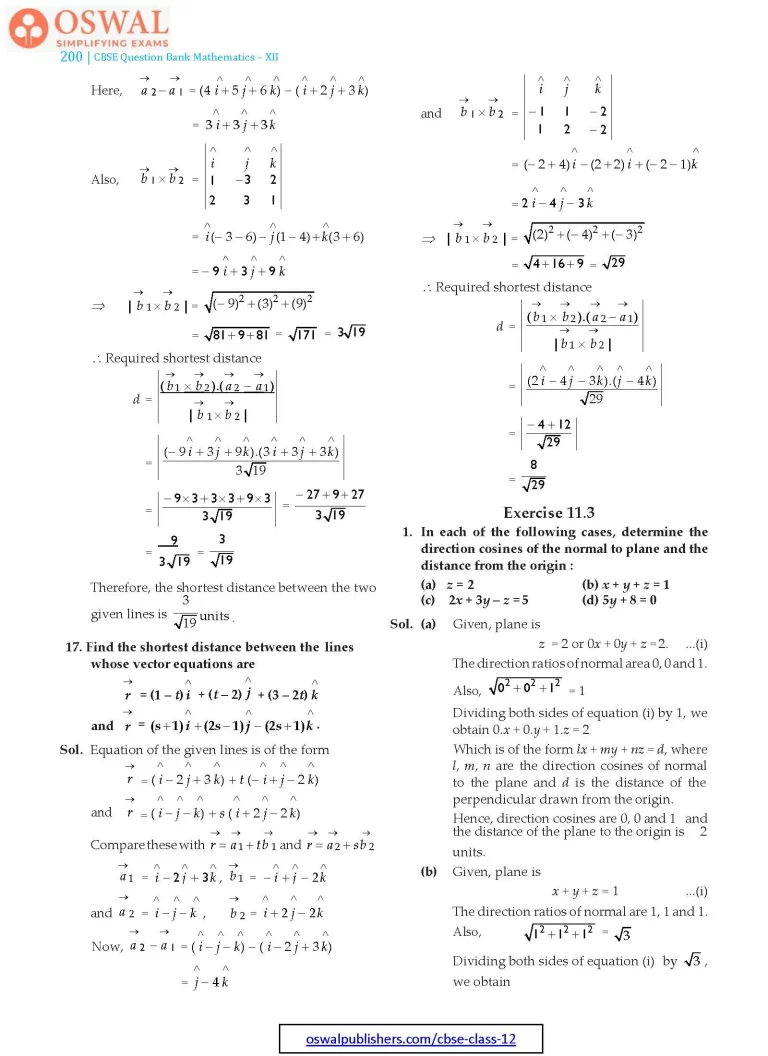
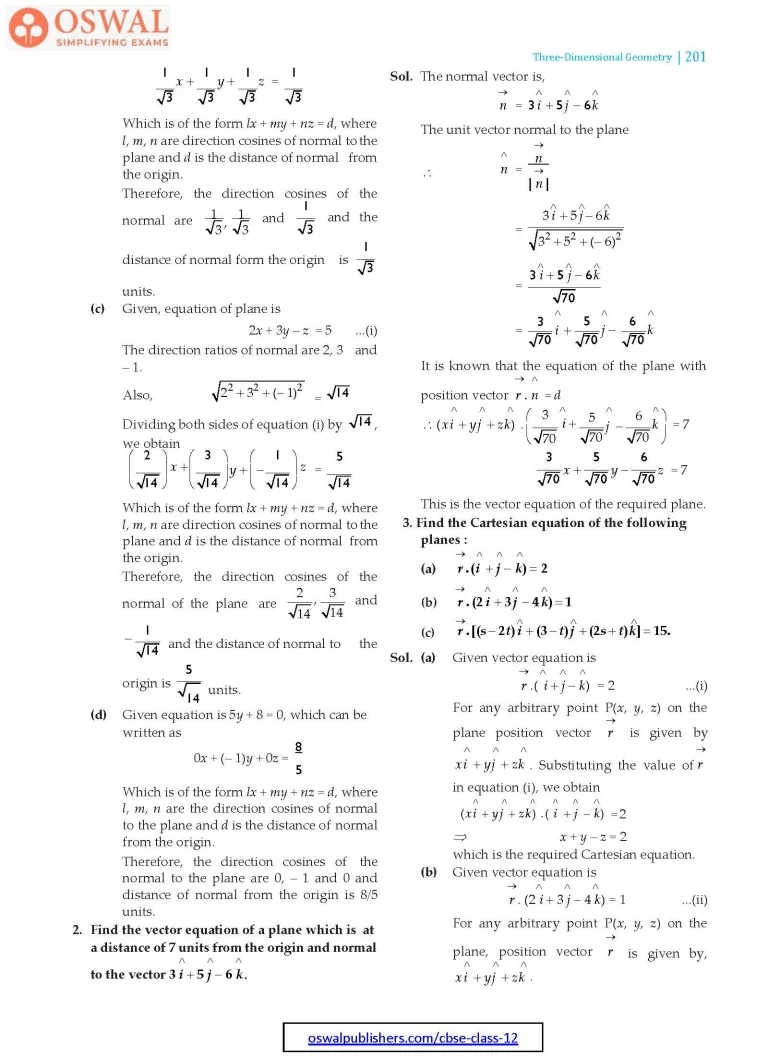
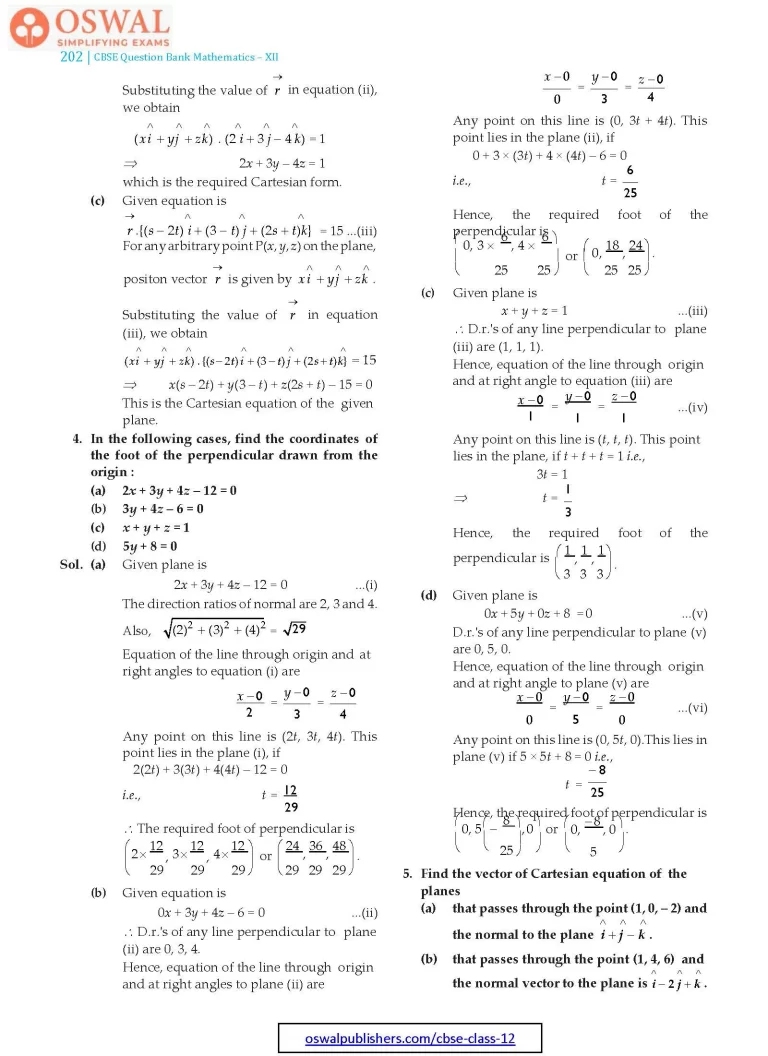
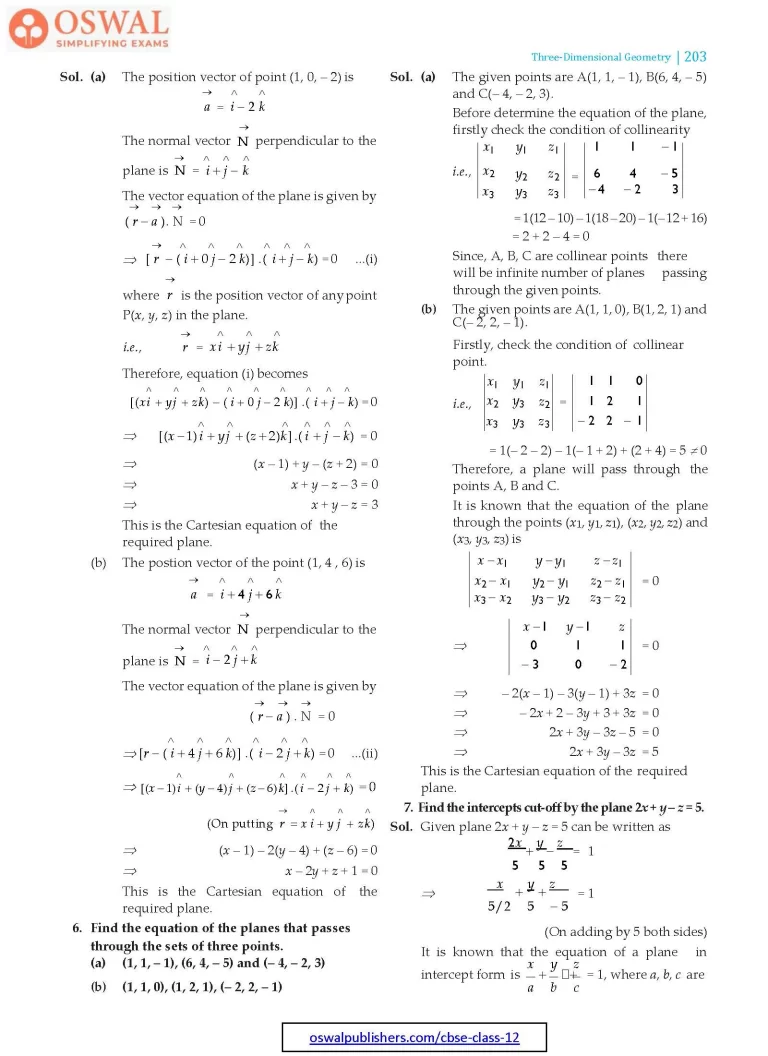
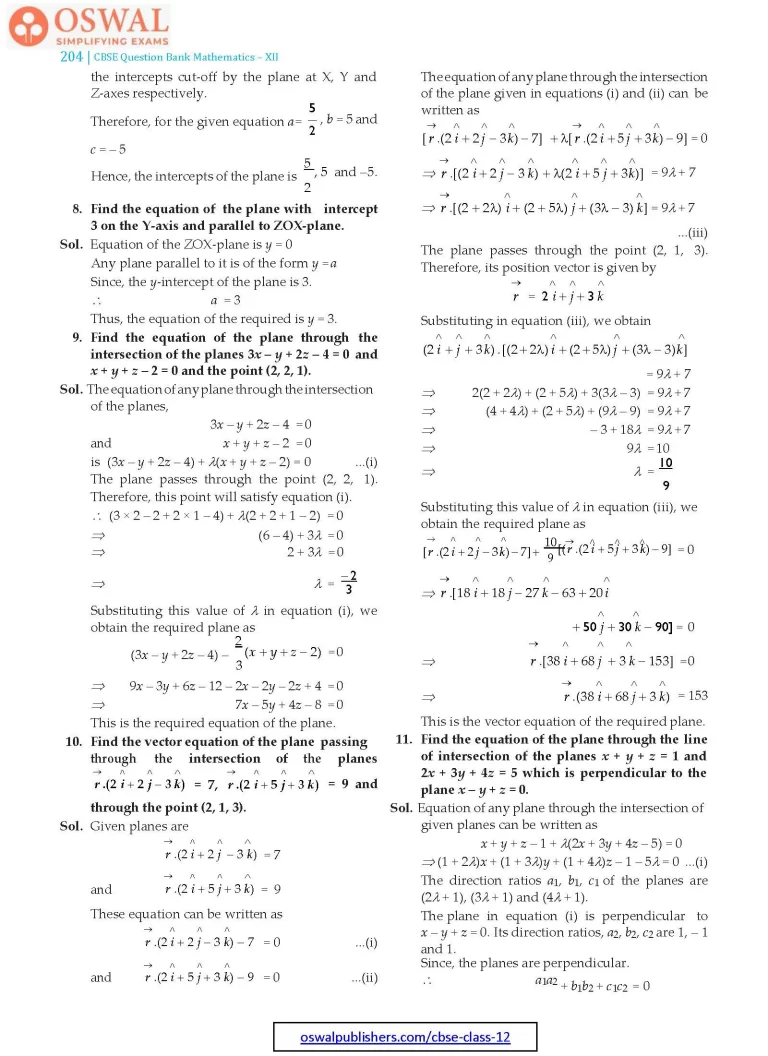

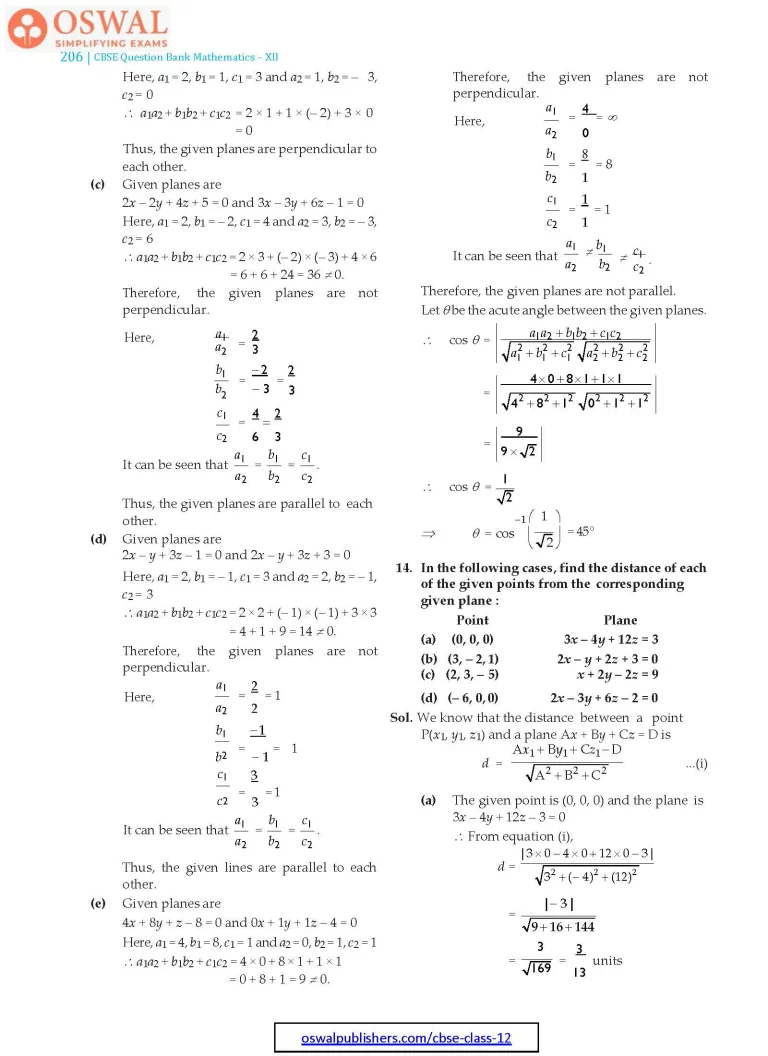
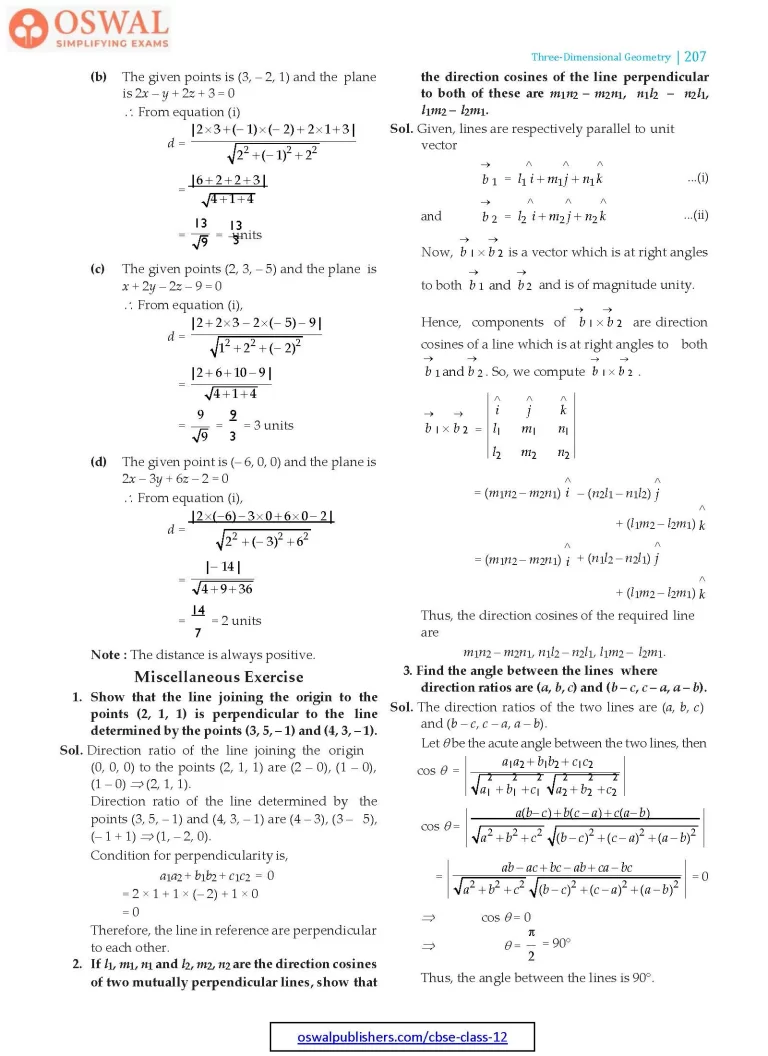
Access Exercises of Class 12 Maths Chapter 11 – Three Dimensional Geometry
Exercise 11.1 Solutions 5 Questions
Exercise 11.2 Solutions 17 Questions
Exercise 11.3 Solutions 14 Questions
Miscellaneous Exercise On Chapter 11 Solutions 23 Questions
Exercise 11.3
1. In each of the following cases, determine the direction cosines of the normal to plane and the distance from the origin :
(a) z = 2
(b) x + y + z = 1
(c) 2x + 3y – z = 5
(d) 5y + 8 = 0
Sol. (a) Given, plane is
z = 2 or 0x + 0y + z = 2. ...(i)
The direction ratios of normal area 0, 0 and 1.
$$\text{Also,\space}\sqrt{0^{2}+0^{2}+1^{2}}=1$$
Dividing both sides of equation (i) by 1, we obtain 0.x + 0.y + 1.z = 2
Which is of the form lx + my + nz = d, where l, m, n are the direction cosines of normal to the plane and d is the distance of the perpendicular drawn from the origin.
Hence, direction cosines are 0, 0 and 1 and the distance of the plane to the origin is 2 units.
(b) Given, plane is
x + y + z = 1 ...(i)
The direction ratios of normal are 1, 1 and 1.
$$\text{Also,\space}\sqrt{1^{2}+1^{2}+1} =\sqrt{3}\\\text{Dividing both sides of equation (i) by}\\\sqrt{3},\\\text{we obtain}$$
$$\frac{1}{\sqrt{3}}x+\frac{1}{\sqrt{3}}y +\frac{1}{\sqrt{3}}z=\frac{1}{\sqrt{3}}$$
Which is of the form lx + my + nz = d, where l, m, n are direction cosines of normal to the plane and d is the distance of normal from the origin.
Therefore, the direction cosines of the normal are
$$\frac{1}{\sqrt{3}},\frac{1}{\sqrt{3}},\textbf{and}\frac{1}{\sqrt{3}}\space\text{and the distance of}\\\text{normal form the origin is}\frac{1}{\sqrt{3}}\text{units.}$$
(c) Given, equation of plane is
2x + 3y – z = 5 ...(i)
The direction ratios of normal are 2, 3 and – 1.
$$\text{Also,}\space \sqrt{2^{2}+3^{2}+(-1)^{2}} \\=\sqrt{14}\\\text{Dividing both sides of equation (i) by}\\\sqrt{14}\space\text{we obtain}\\\bigg(\frac{2}{\sqrt{14}}\bigg)x + \bigg(\frac{3}{\sqrt{14}}\bigg)y +\\\bigg(-\frac{1}{\sqrt{14}}\bigg)z =\frac{5}{\sqrt{14}}$$
Which is of the form lx + my + nz = d, where l, m, n are direction cosines of normal to the plane and d is the distance of normal from the origin.
Therefore, the direction cosines of the normal of the plane are
$$\frac{2}{\sqrt{14}},\frac{3}{\sqrt{14}},\text{and}\space-\frac{1}{\sqrt{14}}\space\\\text{and the distance of normal to the}\\\text{origin is}\space\frac{5}{\sqrt{14}}\space\text{units.}$$
(d) Given equation is 5y + 8 = 0, which can be written as
$$0x + (-1)y + 0 z =\frac{8}{5} $$
Which is of the form lx + my + nz = d, where l, m, n are the direction cosines of normal to the plane and d is the distance of normal from the origin.
Therefore, the direction cosines of the normal to the plane are 0, – 1 and 0 and distance of normal from the origin is 8/5 units.
2. Find the vector equation of a plane which is at a distance of 7 units from the origin and normal to the vector
$$\textbf{3}\hat{\textbf{i}} \textbf{+ 5}\hat{\textbf{j}}\textbf{- 6}\hat{\textbf{k}}\textbf{.}$$
Sol. The normal vector is,
$$\vec{n} = 3\hat{i} + 5\hat{j}-6\hat{k}$$
The unit vector normal to the plane
$$\therefore\space\hat{n} =\frac{\vec{v}}{|\vec{n}|}\\=\frac{3\hat{i}+5\hat{j}+6\hat{k}}{\sqrt{3^{2}+5^{2}+(-6)^{2}}}\\=\frac{3\hat{i}+5\hat{j}-6\hat{k}}{\sqrt{70}}\\=\frac{3}{\sqrt{70}}\hat{i} + \frac{5}{\sqrt{70}}\hat{j} -\frac{6}{\sqrt{70}}\hat{k}$$
It is known that the equation of the plane with position vector
$$\vec{r}.\hat{n} = d\\\therefore\space(x\hat{i} + y\hat{j}+z\hat{k}).\\\begin{pmatrix}\frac{3}{\sqrt{70}}\hat{i} + \frac{5}{\sqrt{70}}\hat{j} - \frac{6}{\sqrt{70}}\hat{k}\end{pmatrix}= 7\\=\frac{3}{\sqrt{70}}x+\frac{5}{\sqrt{70}} y -\frac{6}{\sqrt{70}}z =7$$
This is the vector equation of the required plane.
3. Find the Cartesian equation of the following planes :
$$\textbf{(a)\space}\vec{\textbf{r}}\textbf{.(}\hat{\textbf{i}}\textbf{+}\hat{\textbf{j}}\textbf{-}\hat{\textbf{k}})\textbf{= 2}\\\textbf{(b)\space}\vec{\textbf{r}}\textbf{.}\textbf{(2}\hat{\textbf{i}} \textbf{+ 3}\hat{\textbf{j}}\textbf{-4}\hat{\textbf{k}})\textbf{= 1}\\\textbf{(c)\space}\vec{\textbf{r}}\textbf{.}\lbrack\textbf{(}\textbf{s - 2t)}\hat{\textbf{i}} \textbf{+} \textbf{(3-t)}\hat{\textbf{j}} \textbf{+ (2s+t)}\hat{\textbf{k}}\rbrack\textbf{= 15}.$$
Sol. (a) Given vector equation is
$$\vec{r}.(\hat{i} + \hat{j}-\hat{k})=2\space\text{...(i)}$$
For any arbitrary point P(x, y, z) on the plane position vector
$$\vec{r}\space\text{is given by}\space x\hat{i} + y\hat{j}+z\hat{k}.\\\text{Substituting the value of}\space\vec{r}\space\\\text{in equation (i), we obtain}\\(x\hat{i} + y\hat{j}+z\hat{k}).(\hat{i}+\hat{j}-\hat{k})=2\\\Rarr\space x+y-z=2$$
which is the required Cartesian equation.
(b) Given vector equation is
$$\vec{r}.(2\hat{i}+3\hat{j}-4\hat{k})=1\space\text{...(iii)}$$
For any arbitrary point P(x, y, z) on the plane, position vector
$$\vec{r}\space\text{is given by,}\space x\hat{i} + y\hat{j}+z\hat{k}.\\\text{Substituting the value of}\space\vec{r}\space\\\text{in equation (ii), we obtain}\\(x\hat{i} + y\hat{j} +z\hat{k}).(2\hat{i}+3\hat{j}-4\hat{k})=1\\\Rarr\space 2x + 3y -4z=1$$
which is the required Cartesian form.
(c) Given equation is
$$\vec{r}.\lbrack(s-2t)\hat{i} + (3-t)\hat{j}+(2s-t)\hat{k}\rbrack=15\\\text{...(iii)}$$
For any arbitrary point P(x, y, z) on the plane, positon vector
$$\vec{r}\space\text{is given by}\space x\hat{i}+y\hat{j}+z\hat{k}.\\\text{Substituting the value of}\space\vec{r}\space\\\text{in equation (iii), we obtain}$$
$$(x\hat{i} + y\hat{j}+z\hat{k}).\\\lbrace(\text{s-2t})\hat{i} + (3-t)\hat{j} + (2s + t)\hat{k}\rbrace=15\\\Rarr\space x((s-2t)) + y(3-t) +z(2s+t)-15 =0$$
This is the Cartesian equation of the given plane.
4. In the following cases, find the coordinates of the foot of the perpendicular drawn from the origin :
(a) 2x + 3y + 4z – 12 = 0
(b) 3y + 4z – 6 = 0
(c) x + y + z = 1
(d) 5y + 8 = 0
Sol. (a) Given plane is
2x + 3y + 4z – 12 = 0 ...(i)
The direction ratios of normal are 2, 3 and 4.
$$\text{Also},\space\sqrt{(2)^{2} + (3)^{2} +(4)^{2}} =\sqrt{29}$$
Equation of the line through origin and at right angles to equation (i) are
$$\frac{x-0}{2}=\frac{y-0}{3}=\frac{z-0}{4}$$
Any point on this line is (2t, 3t, 4t). This point lies in the plane (i), if
2(2t) + 3(3t) + 4(4t) – 12 = 0
$$\text{i.e.,}\space t =\frac{12}{29}$$
∴ The required foot of perpendicular is
$$\bigg(2×\frac{12}{29},3×\frac{12}{29},4×\frac{12}{29}\bigg)\\\text{or}\space\bigg(\frac{24}{29},\frac{36}{29},\frac{48}{29}\bigg).$$
(b) Given equation is
0x + 3y + 4z – 6 = 0 ...(ii)
∴ D.r.'s of any line perpendicular to plane (ii) are 0, 3, 4.
Hence, equation of the line through origin and at right angles to plane (ii) are
$$\frac{x-0}{0}=\frac{y-0}{3}=\frac{z-0}{4}$$
Any point on this line is (0, 3t + 4t). This point lies in the plane (ii), if
0 + 3 × (3t) + 4 × (4t) – 6 = 0
$$\text{i.e.\space} t=\frac{6}{25}$$
Hence, the required foot of the perpendicular is
$$\bigg(0, 3×\frac{6}{25},4×\frac{6}{25}\bigg)\space\text{or}\\\space\bigg(0,\frac{18}{25},\frac{24}{25}\bigg)$$
(c) Given plane is
x + y + z = 1 ...(iii)
∴ D.r.'s of any line perpendicular to plane (iii) are (1, 1, 1).
Hence, equation of the line through origin and at right angle to equation (iii) are
$$\frac{x-0}{1}=\frac{y-0}{1}=\frac{Z-0}{1}\space\text{...(iv)}$$
Any point on this line is (t, t, t). This point lies in the plane, if t + t + t = 1 i.e.,
3t = 1
$$\Rarr\space t = \frac{1}{3}$$
Hence, the required foot of the perpendicular is
$$\bigg(\frac{1}{3},\frac{1}{3},\frac{1}{3}\bigg).$$
(d) Given plane is
0x + 5y + 0z + 8 = 0 ...(v)
D.r.'s of any line perpendicular to plane (v) are 0, 5, 0.
Hence, equation of the line through origin and at right angle to plane (v) are
$$\frac{x-0}{0}=\frac{y-0}{5}=\frac{z-0}{0}=\space\text{...(vi)}$$
Any point on this line is (0, 5t, 0).This lies in plane (v) if 5 × 5t + 8 = 0 i.e.,
$$t =\frac{-8}{25}$$
Hence, the required foot of perpendicular is
$$\bigg(0, 5\bigg(-\frac{8}{25}\bigg),0\bigg)\text{or}\space\bigg(0,\frac{-8}{5},0\bigg).$$
5. Find the vector of Cartesian equation of the planes
(a) that passes through the point (1, 0, – 2) and the normal to the plane
$$\hat{\textbf{i}} \textbf{+} \hat{\textbf{j}} \textbf{-}\hat{\textbf{k}.}$$
(b) that passes through the point (1, 4, 6) and the normal vector to the plane is
$$\hat{\textbf{i}}\space\textbf{- 2}\hat{\textbf{j}} \textbf{+}\hat{\textbf{k}}\textbf{.}$$
Sol. (a) The position vector of point (1, 0, – 2) is
$$\vec{a} =\hat{i} -2\hat{k}\\\text{The normal vector}\space\vec{\text{N}}\space\text{perpendicular to}\\\text{the plane is}\space\vec{\text{N}} =\hat{i} +\hat{j}-\hat{k}\\\text{The vector equation of the plane }\\\text{is given by} \\(\vec{r}-\vec{a}).\vec{\text{N}} = 0\\\Rarr\space \lbrack\vec{r} -(\hat{i} + 0\hat{j}-2\hat{k})\rbrack.(\hat{i} + \hat{j}-\hat{k})=0\\\text{...(i)}\\\text{where}\space\vec{r}\space\text{is the position vector of}\\\text{any point P(x, y, z) in the plane.}\\\text{i.e.\space}\vec{r} = x\hat{i} + y\hat{j} + z\hat{k}$$
Therefore, equation (i) becomes
$$\lbrack(x\hat{i} + y\hat{j} + z\hat{k}) - (\hat{i} + 0\hat{j}-2\hat{k})\rbrack\\.(\hat{i} + \hat{j}-\hat{k}) = 0\\\Rarr\space\lbrack (x-1)\hat{i} + y\hat{j} + (z+2)\hat{k}\rbrack.\\(\hat{i} + \hat{j}-\hat{k}) = 0$$
$$\Rarr\space(x-1) + y(z+2)=0\\\Rarr\space x+y-z-3 =0\\\Rarr\space x+y-z=3$$
This is the Cartesian equation of the required plane.
(b) The postion vector of the point (1, 4 , 6) is
$$\vec{a} = \hat{i} + 4\hat{j}+6\hat{k}\\\text{The normal vector}\space\vec{\text{N}}\space\text{perpendicular}\\\text{to the plane is}\\\vec{\text{N}} = \hat{i}-2\hat{j}+\hat{k}$$
The vector equation of the plane is given by
$$(\vec{r}-\vec{a}).\vec{\text{N}} = 0\\\Rarr\space \lbrack r - (\hat{i} + 4\hat{j}+6\hat{k})\rbrack.(\hat{i}-2\hat{j}+\hat{k}) =0\\\text{...(iii)}\\\Rarr\space\lbrack(x-1)\hat{i} + (y-4)\hat{j} + (z-6)\hat{k}\rbrack.\\(\hat{i}-2\hat{j}+\hat{k})=0\\(\text{On putting}\space \vec{r} = x\hat{i} + y\hat{j}+z\hat{k})\\\Rarr\space(x-1)-2(y-4)+(z-6) =0\\\Rarr\space x-2y+z+1 = 0$$
This is the Cartesian equation of the required plane.
6. Find the equation of the planes that passes through the sets of three points.
(a) (1, 1, – 1), (6, 4, – 5) and (– 4, – 2, 3)
(b) (1, 1, 0), (1, 2, 1), (– 2, 2, – 1)
Sol. (a) The given points are A(1, 1, – 1), B(6, 4, – 5) and C(– 4, – 2, 3).
Before determine the equation of the plane, firstly check the condition of collinearity
$$\text{i.e.,}\begin{vmatrix}x_1 &y_1&z_1\\ x_2 &y_2 &z_2\\ x_3 &y_3 &z_3\end{vmatrix} =\begin{vmatrix}1 &1&-1\\ 6 &4 &-5\\ -4 &-2 &3\end{vmatrix}$$
= 1(12 – 10) – 1(18 – 20) – 1(– 12 + 16)
= 2 + 2 – 4 = 0
Since, A, B, C are collinear points there will be infinite number of planes passing through the given points.
(b) The given points are A(1, 1, 0), B(1, 2, 1) and C(– 2, 2, – 1).
Firstly, check the condition of collinear point.
$$\text{i.e.,}\begin{vmatrix}x_1 &y_1 &z_1\\ x_2 &y_2 &z_2\\ x_3 &y_3 &z_3\end{vmatrix} =\begin{vmatrix}1 &1 &0\\ 1 &2 &1\\-2 &2 &-1\end{vmatrix}$$
= 1(– 2 – 2) – 1(– 1 + 2) + (2 + 4) = 5 ≠ 0
Therefore, a plane will pass through the points A, B and C.
It is known that the equation of the plane through the points (x1, y1, z1), (x2, y2, z2) and (x3, y3, z3) is
$$\begin{vmatrix}x-x_{1} &y-y_{1} &z-z_{1}\\ x_2-x_1 &y_2-y_1 &z_2-z_1\\ x_3-x_2 &y_3-y_2 &z_3-Z_2\end{vmatrix}=0\\\Rarr\space\begin{vmatrix} x-1 &y-1 &z\\ 0 & 1 & 1\\ -3& 0 & -2\end{vmatrix}=0\\\Rarr\space -2(x-1)-3(y-1)+3z =0\\\Rarr\space -2x +2-3y + 3+3z =0\\\Rarr\space 2x+3y-3z-5 =0\\\Rarr\space 2x+3y-3z =5$$
This is the Cartesian equation of the required plane.
7. Find the intercepts cut-off by the plane 2x + y – z = 5.
Sol. Given plane 2x + y – z = 5 can be written as
$$\frac{2x}{5}+\frac{y}{5}+\frac{z}{5}=1\\\Rarr\space \frac{x}{5/2}+ \frac{y}{5}+ \frac{z}{-5}=1$$
(On adding by 5 both sides)
It is known that the equation of a plane in intercept form is
$$\frac{x}{a}+\frac{y}{b}-\frac{z}{c}=1\\\Rarr\space\frac{x}{\frac{5}{2}}+\frac{y}{5}+\frac{z}{-5}=1$$
(On adding by 5 both sides)
It is known that the equation of a plane in intercept form is
$$\frac{x}{a}+\frac{y}{b}+\frac{z}{c}=1,$$
where a, b, c are the intercepts cut-off by the plane at X, Y and Z-axes respectively.
Therefore, for the given equation
$$a =\frac{5}{2}, b=5\space\text{and}\space\text{c=-5}\\\text{Hence, the intercepts of the plane is}\\\frac{5}{2},5\space\text{and}-5.$$
8. Find the equation of the plane with intercept 3 on the Y-axis and parallel to ZOX-plane.
Sol. Equation of the ZOX-plane is y = 0 Any plane parallel to it is of the form y = a Since, the y-intercept of the plane is 3.
∴ a = 3
Thus, the equation of the required is y = 3.
9. Find the equation of the plane through the intersection of the planes 3x – y + 2z – 4 = 0 and x + y + z – 2 = 0 and the point (2, 2, 1).
Sol. The equation of any plane through the intersection of the planes,
3x – y + 2z – 4 = 0
and
x + y + z – 2 = 0
is (3x – y + 2z – 4) + λ(x + y + z – 2) = 0 ...(i)
The plane passes through the point (2, 2, 1). Therefore, this point will satisfy equation (i).
∴ (3 × 2 – 2 + 2 × 1 – 4) + λ(2 + 2 + 1 – 2) = 0
⇒ (6 – 4) + 3λ = 0
⇒ 2 + 3λ = 0
$$\Rarr\space \lambda =\frac{-2}{3}$$
Substituting this value of λ in equation (i), we obtain the required plane as
$$(3x-y+2z-4)-\\\frac{2}{3}(x+y+z)=0$$
⇒ 9x – 3y + 6z – 12 – 2x – 2y – 2z + 4 = 0
⇒ 7x – 5y + 4z – 8 = 0
This is the required equation of the plane.
10. Find the vector equation of the plane passing through the intersection of the planes
$$\vec{\textbf{r}}\textbf{.(2}\hat{\textbf{i}}\textbf{+ 2}\hat{\textbf{j}}\textbf{- 3}\hat{\textbf{k}})\textbf{= 7}\space\textbf{,}\\\space\vec{\textbf{r}}\textbf{.(2}\hat{\textbf{i}}\textbf{+ 5}\hat{\textbf{j}}\textbf{+ 3}\hat{\textbf{k}}\textbf{) = 9}\\\textbf{and through the point (2, 1, 3).}$$
Sol. Given planes are
$$\vec{r}.(2\hat{i}+2\hat{j}-3\hat{k}) = 7\\\text{and}\space\vec{r}\space.(2\hat{i}+5\hat{j}+3\hat{k}) = 9$$
These equation can be written as
$$\vec{r}.(2\hat{i} +2\hat{j}-3\hat{k})-7 = 0\space\text{...(i)}\\\text{and}\space\vec{r}.(2\hat{i} + 5\hat{j}+3\hat{k})-9 =0\space\text{...(ii)}$$
The equation of any plane through the intersection of the plane given in equations (i) and (ii) can be written as
$$\lbrack\vec{r}.(2\hat{i} + 2\hat{j}-3\hat{k})-7\rbrack + \\\lambda\lbrack\vec{r}.(2\hat{i} + 5\hat{j}+3\hat{k})-9\rbrack=0\\\Rarr\space\vec{r}.\lbrack(2\hat{i} + 2\hat{j}-3\hat{k})\rbrack+\\\lambda(2\hat{i} + 5\hat{j}+3\hat{k}) = 9\lambda +7\\\Rarr\space\vec{r}.\lbrack(2 + 2\lambda)\rbrack\hat{i} + (2 + 5\lambda)\hat{j}+ (3\lambda-3)\hat{k}\rbrack\\=9\lambda+7\space\text{...(iii)}$$
The plane passes through the point (2, 1, 3). Therefore, its position vector is given by
$$\vec{r} = 2\hat{i} + \hat{j}+3\hat{k}$$
Substituting in equation (iii), we obtain
$$(2\hat{i} +\hat{j}+3\hat{k}).\lbrack(2 + 2\lambda)\hat{i} + (2 +5\lambda)\hat{j}\\ + (3\lambda-3)\hat{k}\rbrack = 9\lambda +7$$
$$\Rarr\space 2(2+\lambda) + 2(2 + 5\lambda) +\\ 3(3\lambda-3) = 9\lambda + 7\\\Rarr\space (4 + 4\lambda) + (2 + 5\lambda) +(9\lambda -9)\\= 9\lambda +7\\\Rarr\space -3 + 18\lambda = 9\lambda + 7\\\Rarr\space 9\lambda = 10\\\Rarr\lambda\space = \frac{10}{9}$$
Substituting this value of λ in equation (iii), we obtain the required plane as
$$\lbrack\vec{r}.(2\hat{i} + 2\hat{j}-3\hat{k})-7\rbrack +\\\frac{10}{9}\lbrack(\vec{r}.(2\hat{i} + 5\hat{j}+3\hat{k}))-9\rbrack=0\\\Rarr\space\vec{r}.\lbrack 18\hat{i} + 18\hat{j}-27\hat{k} - 63 + 20\hat{i}+\\ 50\hat{j} + 30\hat{k}-90\rbrack = 0\\\Rarr\space \vec{r}.\lbrack38\hat{i} + 18\hat{j}-27\hat{k}-63 + 20\hat{i}\\ + 50\hat{j} + 30\hat{k}-90\rbrack = 0\\\Rarr\space\vec{r}.\lbrack38\hat{i} + 68\hat{j} + 3\hat{k}-153\rbrack = 0\\\Rarr\space\vec{r}.(38\hat{i} + 68\hat{j}+3\hat{k}) = 153 $$
This is the vector equation of the required plane.
11. Find the equation of the plane through the line of intersection of the planes x + y + z = 1 and 2x + 3y + 4z = 5 which is perpendicular to the plane x – y + z = 0.
Sol. Equation of any plane through the intersection of given planes can be written as
x + y + z – 1 + λ(2x + 3y + 4z – 5) = 0
$$\Rarr\space (1 + 2\lambda)x + (1 + 3\lambda)y + \\(1 + 4\lambda)z-1-5\lambda =0\space\text{...(i)}$$
The direction ratios a1, b1, c1 of the planes are
(2λ + 1), (3λ + 1) and (4λ + 1).
The plane in equation (i) is perpendicular to
x – y + z = 0. Its direction ratios, a2, b2, c2 are 1, – 1 and 1.
Since, the planes are perpendicular.
∴ a1a2 + b1b2 + c1c2 = 0
⇒ 1(1 + 2λ) – 1(1 + 3λ) + 1(1 + 4λ) = 0
⇒ 1 + 2λ – 1 – 3λ + 1 + 4λ = 0
⇒ 3λ = – 1
$$\Rarr\space \lambda =-\frac{1}{3}$$
Substituting this value of l in equation (i), we obtain the required plane a
$$\bigg(1 -\frac{2}{3}\bigg)x + \bigg(1 - \frac{2}{3}\bigg)y+\\\bigg(1 - \frac{4}{3}\bigg)z -1 + \frac{5}{3}=0\\\Rarr\space \frac{1}{3}x-\frac{1}{3}z + \frac{2}{3}=0 $$
⇒ x – z + 2 = 0
This the required equation of the plane.
12. Find the angle between the plane whose vector equation
$$\vec{\textbf{r}}\textbf{.(2}\hat{\textbf{i}} \textbf{+ 2}\textbf{j}\textbf{- 3}\hat{\textbf{k}}\textbf{) = 5}\space\textbf{and}\\\vec{\textbf{r}}\textbf{.}\textbf{(3}\hat{\textbf{i}} \textbf{-} \textbf{3}\hat{\textbf{j}} \textbf{+ 5}\hat{\textbf{k}} \textbf{)}\textbf{= 3}.$$
Sol. Given, planes are
$$\vec{r}.(2\hat{i} + 2\hat{j}-3\hat{k})=5\\\text{and}\space \vec{r}.(3\hat{i} - 3\hat{j}+5\hat{k}) = 3$$
It is known that if
$$\vec{n}_1\space\text{and}\space \vec{n}_2\space\text{are normal to the plane,}\\\vec{r}.\vec{n}_1 = d_1\space\text{and}\space \vec{r}.\vec{n}_2 = d_2,$$
then the angle between them is given by
$$\text{cos}\space\theta = \bigg|\frac{\vec{n}_1.\vec{n}_2}{|\vec{n}_1|\vec{n}_2|}\bigg|\space\text{...(i)}\\\text{Here,\space} \vec{n}_1 = 2\hat{i} + 2\hat{j}-3\hat{k}\\\text{and}\space \vec{n}_2 = 3\hat{i}- 3\hat{j}+5\hat{k}\\\therefore\space \vec{n}_1.\vec{n}_2 = (2\hat{i} + 2\hat{j}-3\hat{k}).\\(3\hat{i} - 3\hat{j}+5\hat{k})$$
= 2.3 + 2. (– 3) + (– 3). 5
= 6 – 6 – 15 = – 15
$$|\vec{n}_1| = \sqrt{(2)^{2}+(2)^{2} + (-3)^{2}}\\=\sqrt{4 + 4 + 9} = \sqrt{17}\\|\vec{n}_2| = \sqrt{(3)^{2} + (-3)^{2} + (5)^{2}}\\=\sqrt{9 + 9 + 25} =\sqrt{43}\\\text{Substituting the value of}\space\\\vec{n}_1,\vec{n}_2, |\vec{n}_1|\space\text{and}|\vec{n}_2|\\\text{in equation (i), we obtain}\\\text{cos}\space\theta = \bigg|\frac{-15}{\sqrt{17}\sqrt{43}}\bigg|\\\Rarr\space \text{cos}\space\theta =\frac{15}{\sqrt{731}}\\\Rarr\space \theta = \text{cos}^{\normalsize-1}\bigg(\frac{15}{\sqrt{731}}\bigg) $$
13. In the following cases, determine whether the given planes are parallel or perpendicular and in case they are neither, find the angle between them :
(a) 7x + 5y + 6z + 30 = 0 and 3x – y – 10z + 4 = 0
(b) 2x + y + 3z – 2 = 0 and x – 2y + 5 = 0
(c) 2x – 2y + 4z + 5 = 0 and 3x – 3y + 6z – 1 = 0
(d) 2x – y + 3z – 1 = 0 and 2x – y + 3z + 3 = 0
(e) 4x + 8y + z – 8 = 0 and y + z – 4 = 0.
Sol. (a) Given planes are
7x + 5y + 6z + 30 = 0
and 3x – y – 10z + 4 = 0
Here, a1 = 7, b1 = 5, c1 = 6 and a2 = 3, b2 = – 1, c2 = – 10
∴ a1a2 + b1b2 + c1c2 = 7 × 3 + 5 × (– 1) + 6 × (– 10)
= 21 – 5 – 60
= – 44 ≠ 0
Therefore, the given planes are not perpendicular.
$$\text{Here,\space}\frac{a_1}{a_2}=\frac{7}{3}\\\frac{b_1}{b_2} = \frac{5}{\normalsize-1}=-5\\\frac{c_1}{c_2} = \frac{6}{-10} = \frac{-3}{5}\\\text{It can be seen that}\\\frac{a_1}{a_2}\neq\frac{b_1}{b_2}\neq\frac{c_1}{c_2}.$$
Therefore, the given planes are not parallel. Let θ be the acute angle between the given planes, then
$$\text{cos}\space\theta = \\\bigg|\frac{7×3+5×(\normalsize-1) + 6×(-10)}{\sqrt{7^{2} + 5^{2} + 6^{2}}\sqrt{3^{2} + (-1)^{2} + (-10)^{2}}}\bigg|$$
$$\text{cos}\space\theta = \bigg|\frac{21-5-60}{\sqrt{110}\sqrt{110}}\bigg|\\\Rarr\space \text{cos}\space\theta =\frac{44}{110} = \frac{2}{5}\\\Rarr\space \theta = \text{cos}^{\normalsize-1}\bigg(\frac{2}{5}\bigg)$$
Hence, the angles between the given planes is cos– 1 (2/5)
(b) Given planes are 2x + y + 3z – 2 = 0 and x – 2y + 0z + 5 = 0
Here, a1 = 2, b1 = 1, c1 = 3 and a2 = 1, b2 = – 3, c2 = 0
∴ a1a2 + b1b2 + c1c2 = 2 × 1 + 1 × (– 2) + 3 × 0
= 0
Thus, the given planes are perpendicular to each other.
(c) Given planes are
2x – 2y + 4z + 5 = 0 and 3x – 3y + 6z – 1 = 0
Here, a1 = 2, b1 = – 2, c1 = 4 and a2 = 3, b2 = – 3, c2 = 6
∴ a1a2 + b1b2 + c1c2 = 2 × 3 + (– 2) × (– 3) + 4 × 6
= 6 + 6 + 24 = 36 ≠ 0.
Therefore, the given planes are not perpendicular.
$$\text{Here,}\space\frac{a_1}{a_2} =\frac{2}{3}\\\frac{b_1}{b_2} =\frac{-2}{-3} = \frac{2}{3}\\\frac{c_1}{c_2} = \frac{4}{6} =\frac{2}{3}\\\text{It can be seen that}\\\space\frac{a_1}{a_2} =\frac{b_1}{b_2} =\frac{c_1}{c_2}. $$
Thus, the given planes are parallel to each other.
(d) Given planes are
2x – y + 3z – 1 = 0 and 2x – y + 3z + 3 = 0
Here, a1 = 2, b1 = – 1, c1 = 3 and a2 = 2, b2 = – 1, c2 = 3
∴ a1a2 + b1b2 + c1c2 = 2 × 2 + (– 1) × (– 1) + 3 × 3
= 4 + 1 + 9 = 14 ≠ 0.
Therefore, the given planes are not perpendicular.
$$\text{Here},\space\frac{a_1}{a_2} = \frac{2}{2}=1\\\frac{b_1}{b_2} = \frac{\normalsize-1}{\normalsize-1} = \normalsize -1\\\frac{c_1}{c_2} = \frac{3}{3}=1\\\text{It can be seen that}\\\frac{a_1}{a_2} = \frac{b_1}{b_2}=\frac{c_1}{c_2}.$$
Thus, the given lines are parallel to each other.
(e) Given planes are
4x + 8y + z – 8 = 0 and 0x + 1y + 1z – 4 = 0
Here, a1 = 4, b1 = 8, c1 = 1 and a2 = 0, b2 = 1, c2 = 1
∴ a1a2 + b1b2 + c1c2 = 4 × 0 + 8 × 1 + 1 × 1
= 0 + 8 + 1 = 9 ≠ 0.
Therefore, the given planes are not perpendicular.
$$\text{Here}\space \frac{a_1}{a_2} = \frac{4}{0} = \infty\\\frac{b_1}{b_2} =\frac{8}{1} = 8\\\frac{c_1}{c_2} =\frac{1}{1}=1\\\text{It can be seen that}\\\frac{a_1}{a_2}\neq\frac{b_1}{b_2}\neq\frac{c_1}{c_2}.$$
Therefore, the given planes are not parallel.
Let θ be the acute angle between the given planes.
$$\therefore\space\text{cos}\space\theta \\= \bigg|\frac{a_1a_2 + b_1b_2 + c_1c_2}{\sqrt{a_1^{2} + b_1^{2} + c_1^{2}}\sqrt{a_2^{2} + b_2^{2} + c_2^{2}}}\bigg|\\=\bigg|\frac{4×0 + 8×1 +1×1}{\sqrt{4^{2}+8^{2}+ 1^{2}}\sqrt{0^{2} + 1^{2}+1^{2}}}\bigg|\\=\bigg|\frac{9}{9×\sqrt{2}}\bigg|\\\therefore\space\text{cos}\space\theta = \frac{1}{\sqrt{2}}$$
$$\Rarr\space\theta = \text{cos}^{\normalsize-1}\bigg(\frac{1}{\sqrt{2}}\bigg)= 45\degree$$
14. In the following cases, find the distance of each of the given points from the corresponding given plane :
| Point | Plane | |
| (a) | (0, 0, 0) | 3x – 4y + 12z = 3 |
| (b) | (3, – 2, 1) | 2x – y + 2z + 3 = 0 |
| (c) | (2, 3, – 5) | x + 2y – 2z = 9 |
| (d) | (– 6, 0, 0) | 2x – 3y + 6z – 2 = 0 |
Sol. We know that the distance between a point
P(x1, y1, z1) and a plane Ax + By + Cz = D is
$$d = \frac{Ax_1 + By_1 + Cz_1 - D}{\sqrt{A^{2} + B^{2} + C^{2}}}\space\text{...(i)}$$
(a) The given point is (0, 0, 0) and the plane is 3x – 4y + 12z – 3 = 0
∴ From equation (i),
$$d = \frac{|3×0-4×0 +12×0-3|}{\sqrt{3^{2} + (\normalsize-4)^{2} + (12)^{2}}}\\ = \frac{|-3|}{\sqrt{9 + 16 +144}}\\=\frac{3}{\sqrt{169}} =\frac{3}{13}\space\text{units}$$
(b) The given points is (3, – 2, 1) and the plane is 2x – y + 2z + 3 = 0
∴ From equation (i)
$$d = \\\frac{|2×3 + (\normalsize-1)×(-2) +2×1 +3|}{\sqrt{2^{2} +(-1)^{2} + 2^{2}}}\\=\frac{|6 +2 + 2+3|}{\sqrt{4+1+4}}\\=\frac{13}{\sqrt{9}} = \frac{13}{3}\space\text{units}$$
(c) The given points (2, 3, – 5) and the plane is x + 2y – 2z – 9 = 0
∴ From equation (i),
$$d =\frac{|2 + 2×3-2×(-5)-9|}{\sqrt{1^{2} + 2^{2}+(-2)^{2}}}\\=\frac{|2 + 6 + 10-9|}{\sqrt{4 + 1+4}}\\=\frac{9}{\sqrt{9}} =\frac{9}{3} =\text{3 units}$$
(d) The given point is (– 6, 0, 0) and the plane is 2x – 3y + 6z – 2 = 0
∴ From equation (i),
$$d = \frac{|2×(\normalsize-6)-3×0 + 6×0-2|}{\sqrt{2^{2}+(-3)^{2} + 6^{2}}}\\=\frac{|-14|}{\sqrt{4 +9 + 36}}\\=\frac{14}{7}\space\text{ = 2\space units}\\\textbf{Note:}\space\text{The distance is always positive.}$$
Share page on
NCERT Solutions Class 12 Mathematics
- Chapter 1 Relations and Functions
- Chapter 2 Inverse Trigonometric Functions
- Chapter 3 Matrices
- Chapter 4 Determinants
- Chapter 5 Continuity and Differentiability
- Chapter 6 Application of Derivatives
- Chapter 7 Integrals
- Chapter 8 Applications of the Integrals
- Chapter 9 Differential Equations
- Chapter 10 Vectors
- Chapter 11 Three-Dimensional Geometry
- Chapter 12 Linear Programming
- Chapter 13 Probability
CBSE CLASS 12 NCERT SOLUTIONS
- NCERT Solutions Class 12 English Core
- NCERT Solutions Class 12 Physics
- NCERT Solutions Class 12 Chemistry
- NCERT Solutions Class 12 Biology
- NCERT Solutions Class 12 Business Studies
- NCERT Solutions Class 12 Mathematics
- NCERT Solutions Class 12 Accountancy
- NCERT Solutions Class 12 Economics
- NCERT Solutions Class 12 Geography
- NCERT Solutions Class 12 History
- NCERT Solutions Class 12 Political Science
CBSE CLASS 12 SYLLABUS
- CBSE Class 12 English core Syllabus
- CBSE Class 12 Mathematics Syllabus
- CBSE Class 12 Physics Syllabus
- CBSE Class 12 Chemistry Syllabus
- CBSE Class 12 Biology Syllabus
- CBSE Class 12 Accountancy Syllabus
- CBSE Class 12 Business Studies Syllabus
- CBSE Class 12 Economics Syllabus
- CBSE Class 12 History Syllabus
- CBSE Class 12 Geography Syllabus
- CBSE Class 12 Political science Syllabus
- CBSE Class 12 Sociology Syllabus
- CBSE Class 12 Psychology Syllabus
- CBSE Class 12 Physical education Syllabus
- CBSE Class 12 Applied mathematics Syllabus
- CBSE Class 12 History of Indian Arts Syllabus
CBSE CLASS 12 Notes
- CBSE Class 12 Physics Notes
- CBSE Class 12 Chemistry Notes
- CBSE Class 12 Biology Notes
- CBSE Class 12 Maths Notes
- CBSE Class 12 Accountancy Notes
- CBSE Class 12 Business Studies Notes
- CBSE Class 12 Economics Notes
- CBSE Class 12 History Notes
- CBSE Class 12 Geography Notes
- CBSE Class 12 Political Science Notes

